Interpersonal Synchrony Affects the Full-Body Illusion
Abstract
Featured Application
Abstract
1. Introduction
- H: Differences in the synchronization of bodily movements with another person lead to changes in body perception.
2. Materials and Methods
2.1. Participants
2.2. System
2.3. Experimental Task
2.4. Conditions
2.5. Procedure
2.6. Evaluation
3. Results
4. Discussion
5. Conclusions
Author Contributions
Funding
Institutional Review Board Statement
Informed Consent Statement
Data Availability Statement
Acknowledgments
Conflicts of Interest
Abbreviations
| FBI | Full-body illusion |
| MMD | Head-mounted display |
| OS | Other in sync |
| OA | Other in async |
Appendix A. Pre-Screening
Appendix A.1. Task, Conditions, and Procedure
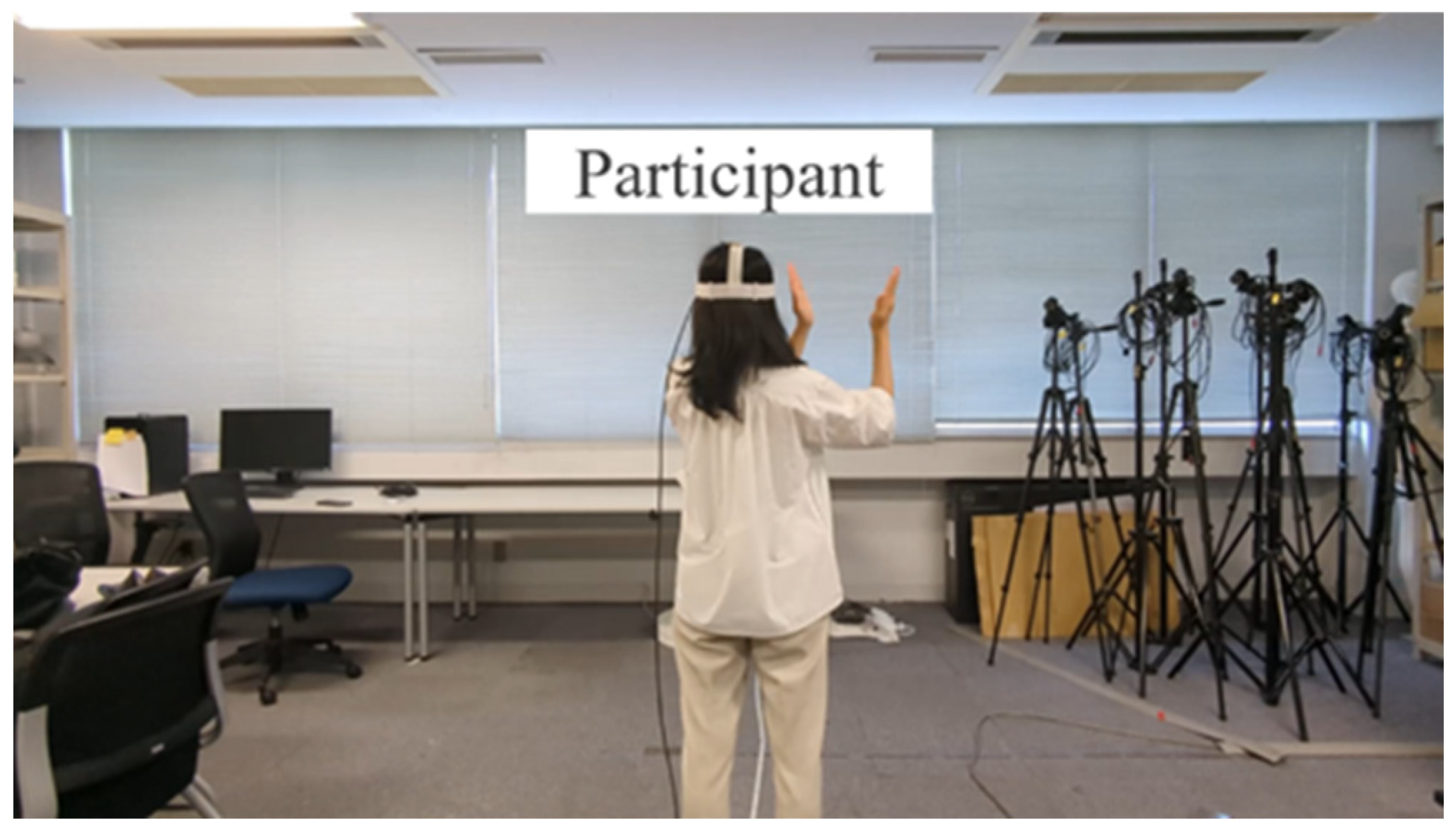
Appendix A.2. Evaluation
Appendix A.3. Result
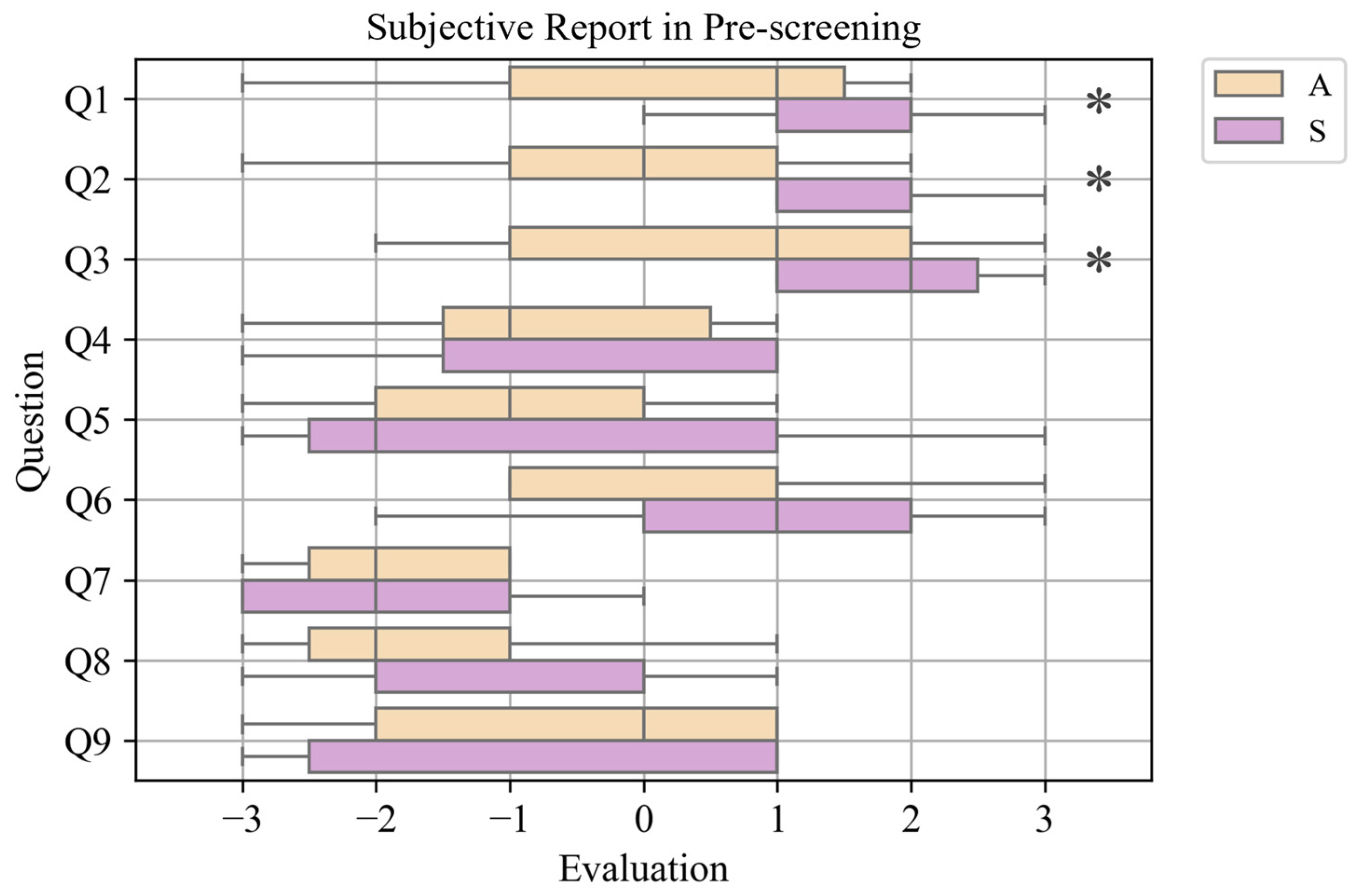
| Question Number | Q1 | Q2 | Q3 | Q4 | Q5 | Q6 | Q7 | Q8 | Q9 |
|---|---|---|---|---|---|---|---|---|---|
| W | 0 | 0 | 1.5 | 5 | 12 | 10 | 6 | 13 | 4.5 |
| p | 0.016 * | 0.010 * | 0.034 * | 0.246 | 0.726 | 0.497 | 0.655 | 0.470 | 0.854 |
| r | 0.488 | 0.686 | 0.438 | 0.273 | −0.017 | 0.198 | 0.041 | 0.099 | 0.033 |
Appendix B. Results Including All Participants
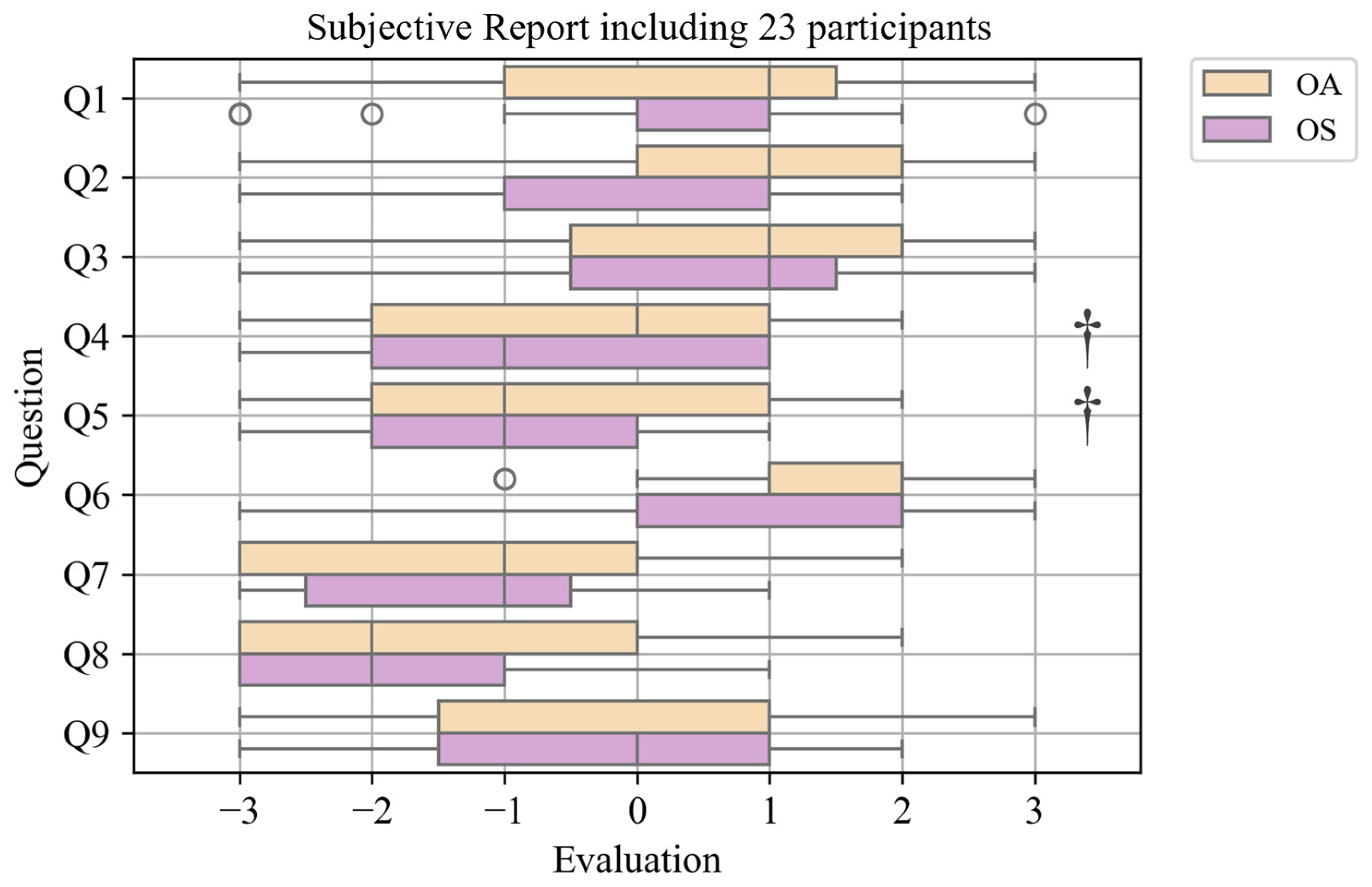
| Question Number | Q1 | Q2 | Q3 | Q4 | Q5 | Q6 | Q7 | Q8 | Q9 |
|---|---|---|---|---|---|---|---|---|---|
| W | 51 | 41 | 23 | 14 | 9 | 20 | 14.5 | 21 | 6 |
| p | 0.923 | 0.151 | 0.643 | 0.085 † | 0.056 † | 0.218 | 0.608 | 0.854 | 0.161 |
| r | 0.000 | 0.348 | 0.087 | 0.217 | 0.261 | 0.130 | 0.087 | −0.043 | 0.130 |
References
- Kilteni, K.; Maselli, A.; Kording, K.P.; Slater, M. Over My Fake Body: Body Ownership Illusions for Studying the Multisensory Basis of Own-Body Perception. Front. Hum. Neurosci. 2015, 9, 141. [Google Scholar] [CrossRef]
- Matsumiya, K. Separate Multisensory Integration Processes for Ownership and Localization of Body Parts. Sci. Rep. 2019, 9, 652. [Google Scholar] [CrossRef]
- Lenggenhager, B.; Tadi, T.; Metzinger, T.; Blanke, O. Video Ergo Sum: Manipulating Bodily Self-Consciousness. Science 2007, 317, 1096–1099. [Google Scholar] [CrossRef]
- Lenggenhager, B.; Mouthon, M.; Blanke, O. Spatial Aspects of Bodily Self-Consciousness. Conscious. Cogn. 2009, 18, 110–117. [Google Scholar] [CrossRef]
- Aspell, J.E.; Lenggenhager, B.; Blanke, O. Keeping in Touch with One’s Self: Multisensory Mechanisms of Self-Consciousness. PLoS ONE 2009, 4, e6488. [Google Scholar] [CrossRef]
- Ionta, S.; Heydrich, L.; Lenggenhager, B.; Mouthon, M.; Fornari, E.; Chapuis, D.; Gassert, R.; Blanke, O. Multisensory Mechanisms in Temporo-Parietal Cortex Support Self-Location and First-Person Perspective. Neuron 2011, 70, 363–374. [Google Scholar] [CrossRef]
- Pfeiffer, C.; Lopez, C.; Schmutz, V.; Duenas, J.A.; Martuzzi, R.; Blanke, O. Multisensory Origin of the Subjective First-Person Perspective: Visual, Tactile, and Vestibular Mechanisms. PLoS ONE 2013, 8, e61751. [Google Scholar] [CrossRef]
- Botvinick, M.; Cohen, J. Rubber Hands ‘Feel’ Touch That Eyes See. Nature 1998, 391, 756. [Google Scholar] [CrossRef]
- Pyasik, M.; Ciorli, T.; Pia, L. Full Body Illusion and Cognition: A Systematic Review of the Literature. Neurosci. Biobehav. Rev. 2022, 143, 104926. [Google Scholar] [CrossRef]
- Petkova, V.I.; Ehrsson, H.H. If I Were You: Perceptual Illusion of Body Swapping. PLoS ONE 2008, 3, e3832. [Google Scholar] [CrossRef]
- Blanke, O. Multisensory Brain Mechanisms of Bodily Self-Consciousness. Nat. Rev. Neurosci. 2012, 13, 556–571. [Google Scholar] [CrossRef]
- Dieguez, S.; Lopez, C. The Bodily Self: Insights from Clinical and Experimental Research. Ann. Phys. Rehabil. Med. 2017, 60, 198–207. [Google Scholar] [CrossRef]
- Hara, M.; Salomon, R.; van der Zwaag, W.; Kober, T.; Rognini, G.; Nabae, H.; Yamamoto, A.; Blanke, O.; Higuchi, T. A Novel Manipulation Method of Human Body Ownership Using an fMRI-Compatible Master–Slave System. J. Neurosci. Methods 2014, 235, 25–34. [Google Scholar] [CrossRef]
- Swinkels, L.M.J. The Self-Generated Full Body Illusion Is Accompanied by Impaired Detection of Somatosensory Stimuli. Acta Psychol. 2020, 203, 102987. [Google Scholar] [CrossRef]
- Maselli, A.; Slater, M. The Building Blocks of the Full Body Ownership Illusion. Front. Hum. Neurosci. 2013, 7, 83. [Google Scholar] [CrossRef]
- Preston, C.; Kuper-Smith, B.J.; Ehrsson, H.H. Owning the Body in the Mirror: The Effect of Visual Perspective and Mirror View on the Full-Body Illusion. Sci. Rep. 2015, 5, 18345. [Google Scholar] [CrossRef]
- Bernieri, F.J.; Rosenthal, R. Interpersonal Coordination: Behavior Matching and Interactional Synchrony. In Fundamentals of Nonverbal Behavior: Studies in Emotion and Social Interaction; Cambridge University Press: Cambridge, UK, 1991; pp. 401–432. [Google Scholar]
- Lakens, D.; Stel, M. If They Move in Sync, They Must Feel in Sync: Movement Synchrony Leads to Attributions of Rapport and Entitativity. Soc. Cogn. 2011, 29, 1–14. [Google Scholar] [CrossRef]
- Lumsden, J.; Miles, L.K.; Macrae, C.N. Sync or Sink? Interpersonal Synchrony Impacts Self-Esteem. Front. Psychol. 2014, 5, 1064. [Google Scholar] [CrossRef]
- Reddish, P.; Fischer, R.; Bulbulia, J. Let’s Dance Together: Synchrony, Shared Intentionality and Cooperation. PLoS ONE 2013, 8, e71182. [Google Scholar] [CrossRef]
- Lang, M.; Bahna, V.; Shaver, J.H.; Reddish, P.; Xygalatas, D. Sync to Link: Endorphin-Mediated Synchrony Effects on Cooperation. Biol. Psychol. 2017, 127, 191–197. [Google Scholar] [CrossRef]
- Fujiwara, K.; Nomura, K.; Eto, M. Antiphase Synchrony Increases Perceived Entitativity and Uniqueness: A Joint Hand-Clapping Task. Front. Psychol. 2023, 14, 1069660. [Google Scholar] [CrossRef]
- Nakul, E.; Orlando-Dessaints, N.; Lenggenhager, B.; Lopez, C. Measuring Perceived Self-Location in Virtual Reality. Sci. Rep. 2020, 10, 6802. [Google Scholar] [CrossRef]
- Reader, A.T.; Trifonova, V.S.; Ehrsson, H.H. The Relationship Between Referral of Touch and the Feeling of Ownership in the Rubber Hand Illusion. Front. Psychol. 2021, 12, 629590. [Google Scholar] [CrossRef]
- Tsakiris, M. My Body in the Brain: A Neurocognitive Model of Body-Ownership. Neuropsychologia 2010, 48, 703–712. [Google Scholar] [CrossRef]
- Petkova, V.I.; Khoshnevis, M.; Ehrsson, H.H. The Perspective Matters! Multisensory Integration in Ego-Centric Reference Frames Determines Full-Body Ownership. Front. Psychol. 2011, 2, 35. [Google Scholar] [CrossRef]
- Pomés, A.; Slater, M. Drift and Ownership toward a Distant Virtual Body. Front. Hum. Neurosci. 2013, 7, 908. [Google Scholar] [CrossRef]
- Peck, T.C.; Gonzalez-Franco, M. Avatar Embodiment. A Standardized Questionnaire. Front. Virtual Real. 2021, 1, 575943. [Google Scholar] [CrossRef]
- Kannape, O.A.; Blanke, O. Agency, Gait and Self-Consciousness. Int. J. Psychophysiol. 2012, 83, 191–199. [Google Scholar] [CrossRef]
- Pacherie, E. The Phenomenology of Joint Action: Self-Agency vs. Joint-Agency; MIT Press: Cambridge, MA, USA, 2012. [Google Scholar]
- Pacherie, E. How Does It Feel to Act Together? Phenomenol. Cogn. Sci. 2014, 13, 25–46. [Google Scholar] [CrossRef]
- Heydrich, L.; Dodds, T.J.; Aspell, J.E.; Herbelin, B.; Bülthoff, H.H.; Mohler, B.J.; Blanke, O. Visual Capture and the Experience of Having Two Bodies—Evidence from Two Different Virtual Reality Techniques. Front. Psychol. 2013, 4, 946. [Google Scholar] [CrossRef]
- Guterstam, A.; Larsson, D.E.O.; Szczotka, J.; Ehrsson, H.H. Duplication of the Bodily Self: A Perceptual Illusion of Dual Full-Body Ownership and Dual Self-Location. R. Soc. Open Sci. 2020, 7, 201911. [Google Scholar] [CrossRef]
- Miura, R.; Kasahara, S.; Kitazaki, M.; Verhulst, A.; Inami, M.; Sugimoto, M. MultiSoma: Distributed Embodiment with Synchronized Behavior and Perception. In Proceedings of the Augmented Humans Conference 2021, Rovaniemi, Finland, 22–24 February 2021; ACM: New York, NY, USA, 2021; pp. 1–9. [Google Scholar]
- Yakura, H.; Goto, M. Enhancing Participation Experience in VR Live Concerts by Improving Motions of Virtual Audience Avatars. In Proceedings of the 2020 IEEE International Symposium on Mixed and Augmented Reality (ISMAR), Porto de Galinhas, Brazil, 9–13 November 2020; IEEE: Piscataway, NJ, USA, 2020; pp. 555–565. [Google Scholar]
- Thériault, R.; Landry, M.; Raz, A. The Rubber Hand Illusion: Top-down Attention Modulates Embodiment. Q. J. Exp. Psychol. 2022, 75, 2129–2148. [Google Scholar] [CrossRef]
- Asai, T.; Mao, Z.; Sugimori, E.; Tanno, Y. Rubber Hand Illusion, Empathy, and Schizotypal Experiences in Terms of Self-Other Representations. Conscious. Cogn. 2011, 20, 1744–1750. [Google Scholar] [CrossRef]
- Forster, P.-P.; Karimpur, H.; Fiehler, K. Demand Characteristics Challenge Effects in Embodiment and Presence. Sci. Rep. 2022, 12, 14084. [Google Scholar] [CrossRef]
- Tan, G.; Uchitomi, H.; Isobe, R.; Miyake, Y. Sense of Embodiment with Synchronized Avatar during Walking in Mixed Reality. Sci. Rep. 2024, 14, 21198. [Google Scholar] [CrossRef]
- Salomon, R.; Lim, M.; Pfeiffer, C.; Gassert, R.; Blanke, O. Full Body Illusion Is Associated with Widespread Skin Temperature Reduction. Front. Behav. Neurosci. 2013, 7, 65. [Google Scholar] [CrossRef]
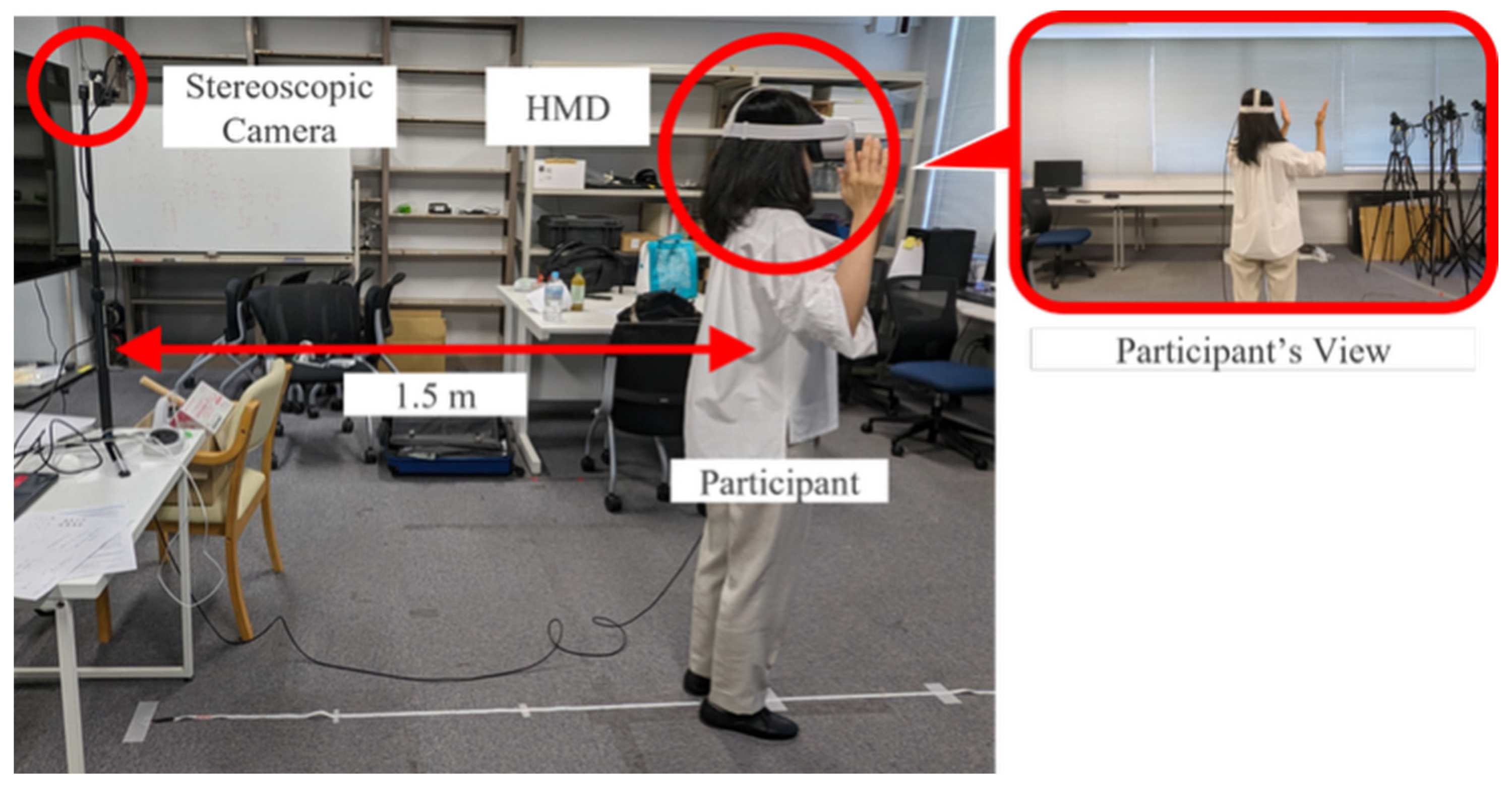
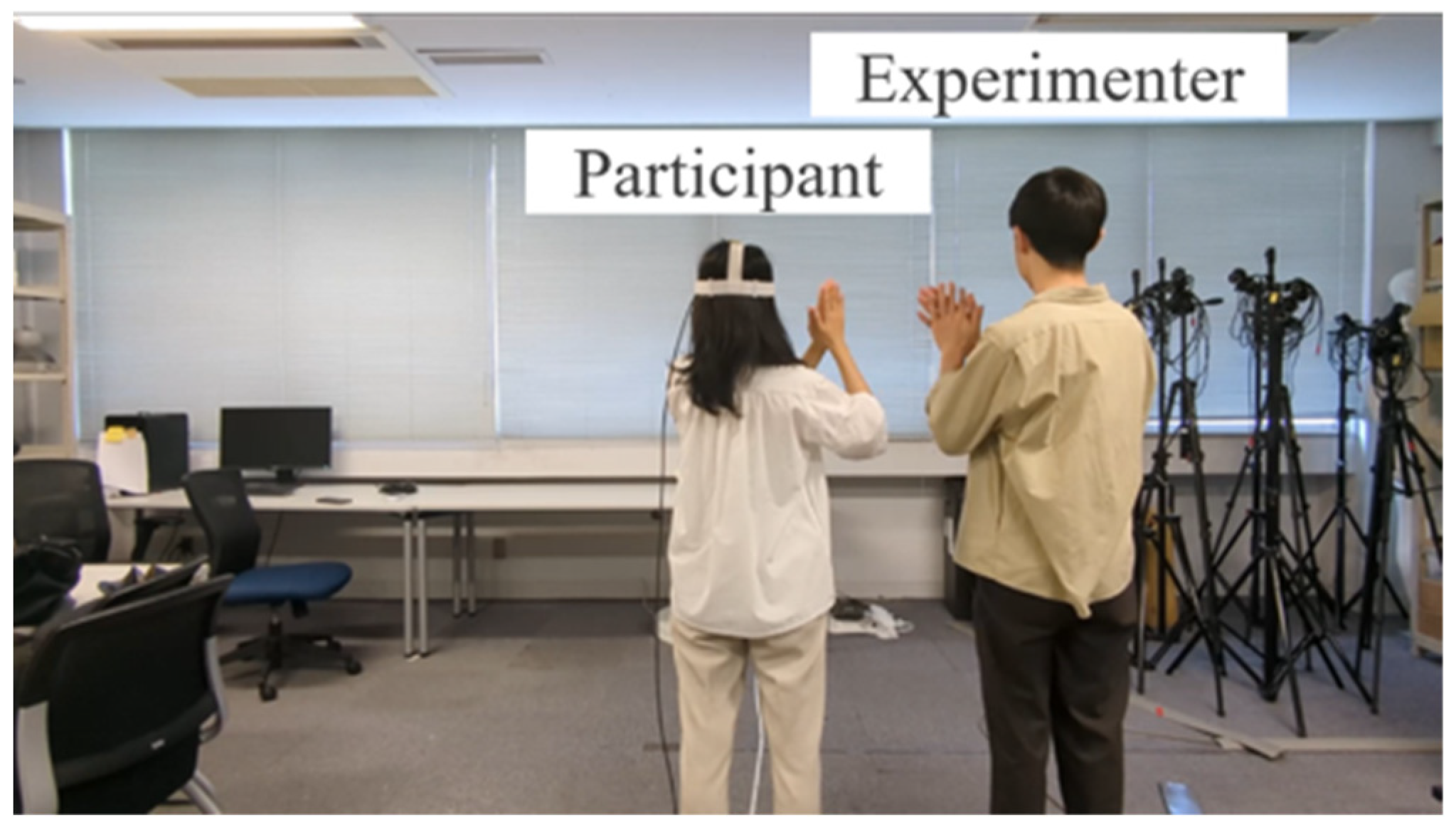
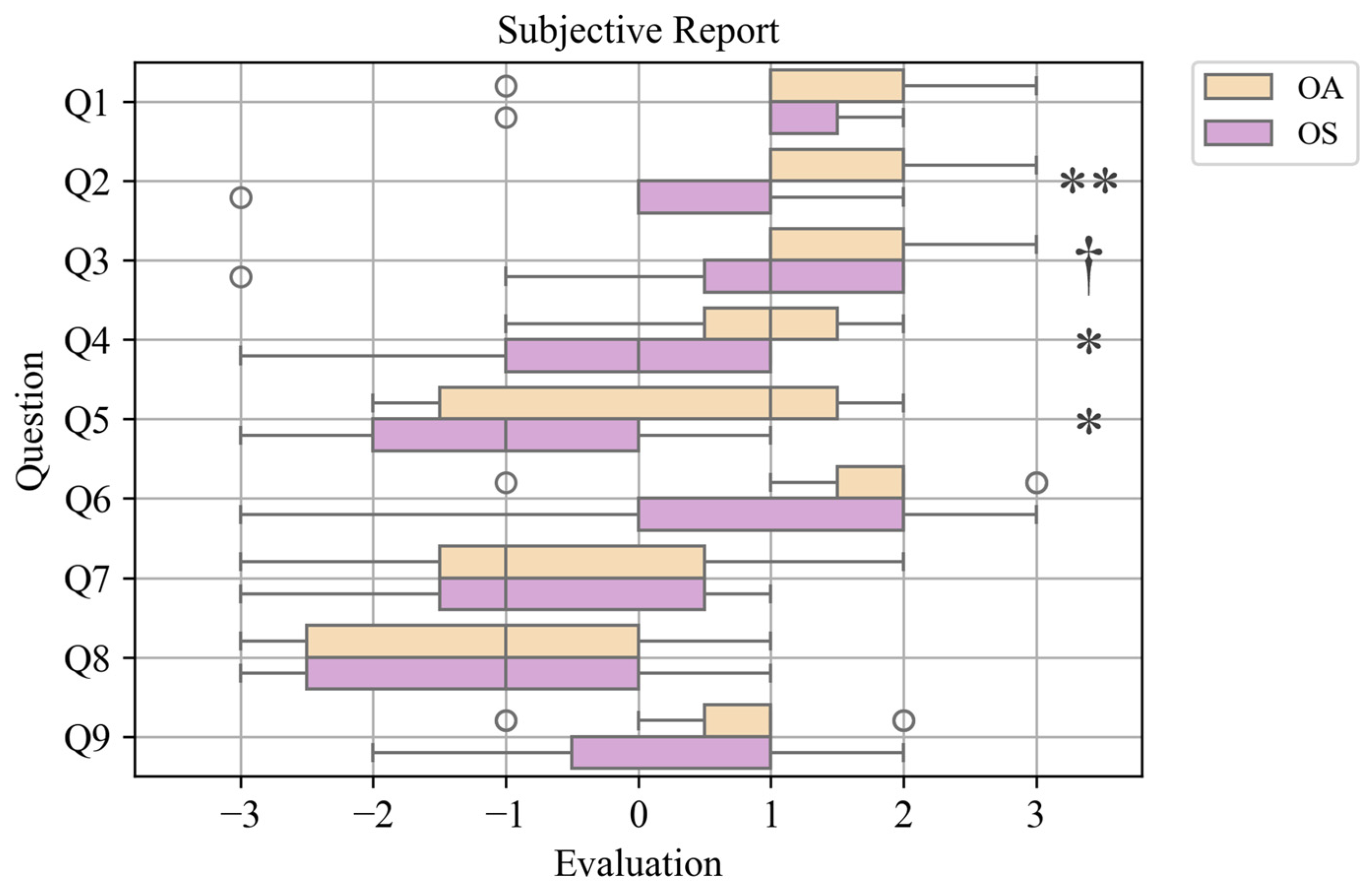
| Question Number | Question Text |
|---|---|
| Q1 | It seemed as if I was feeling the touch of my hand in the location where my hands that I saw clapped. |
| Q2 | It seemed as though the touch I felt was caused by the hands I saw hitting each other. |
| Q3 | I felt as if the body that I saw was my body. |
| Q4 | It seemed as if I might have more than one body. |
| Q5 | It seemed as if the touch I was feeling came from somewhere between my own body and the body that I saw. |
| Q6 | It seemed as if I could control the hand that I saw as my own hand. |
| Q7 | It felt as if my (real) body was drifting toward the front (toward the body that I saw). |
| Q8 | It appeared (visually) as if the body that I saw was drifting backward (toward my body). |
| Q9 | It seemed as though I was in two places at the same time. |
| Question Number | Q1 | Q2 | Q3 | Q4 | Q5 | Q6 | Q7 | Q8 | Q9 |
|---|---|---|---|---|---|---|---|---|---|
| W | 16.5 | 0 | 0 | 2.5 | 2 | 2 | 3.5 | 7 | 2 |
| p | 0.465 | 0.008 ** | 0.066 † | 0.027 * | 0.040 * | 0.129 | 0.577 | 0.891 | 0.257 |
| r | 0.132 | 0.562 | 0.273 | 0.455 | 0.413 | 0.256 | 0.050 | 0.033 | 0.165 |
Disclaimer/Publisher’s Note: The statements, opinions and data contained in all publications are solely those of the individual author(s) and contributor(s) and not of MDPI and/or the editor(s). MDPI and/or the editor(s) disclaim responsibility for any injury to people or property resulting from any ideas, methods, instructions or products referred to in the content. |
© 2025 by the authors. Licensee MDPI, Basel, Switzerland. This article is an open access article distributed under the terms and conditions of the Creative Commons Attribution (CC BY) license (https://creativecommons.org/licenses/by/4.0/).
Share and Cite
Ogawa, H.; Uchitomi, H.; Miyake, Y. Interpersonal Synchrony Affects the Full-Body Illusion. Appl. Sci. 2025, 15, 6870. https://doi.org/10.3390/app15126870
Ogawa H, Uchitomi H, Miyake Y. Interpersonal Synchrony Affects the Full-Body Illusion. Applied Sciences. 2025; 15(12):6870. https://doi.org/10.3390/app15126870
Chicago/Turabian StyleOgawa, Hiromu, Hirotaka Uchitomi, and Yoshihiro Miyake. 2025. "Interpersonal Synchrony Affects the Full-Body Illusion" Applied Sciences 15, no. 12: 6870. https://doi.org/10.3390/app15126870
APA StyleOgawa, H., Uchitomi, H., & Miyake, Y. (2025). Interpersonal Synchrony Affects the Full-Body Illusion. Applied Sciences, 15(12), 6870. https://doi.org/10.3390/app15126870





